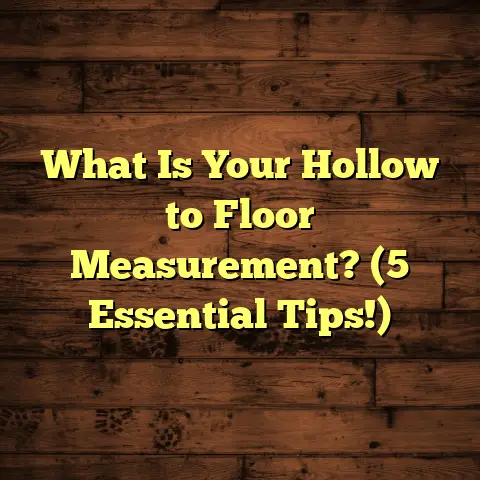What Is a Floating Floor? (5 Benefits You Didn’t Know About!)
When I first got into the flooring business, I quickly realized many homeowners face a pretty frustrating problem: they want beautiful, durable floors but dread the hassle and cost that come with traditional flooring installation. Nails, glue, long drying times, subfloor prep, dust, noise—it all adds up to a stressful process that can disrupt daily life for days or even weeks. I remember one client who was so worried about the mess of installing hardwood floors that she kept postponing the project for years.
That’s when floating floors came to my rescue—and I’ve seen firsthand how they solve a lot of these problems. Floating floors have become my go-to recommendation for clients who want a cost-effective, beautiful floor without the headaches. But not everyone knows exactly what floating floors are or why they might be the best choice for their home or business.
So, I want to share what floating floors really are, how they work, and especially the five surprising benefits that often get overlooked. Along the way, I’ll share stories from my projects, real numbers on costs and installation times, and useful tips that will help you decide if floating floors are right for you.
What Is a Floating Floor?
Let’s start with the basics. You might have heard the term “floating floor” thrown around but wondered what it actually means. Simply put: a floating floor is a type of flooring that isn’t attached directly to the subfloor beneath it by nails or glue. Instead, the planks or tiles connect to each other and rest above the subfloor on a thin cushioning layer called underlayment.
So How Does a Floating Floor Stay in Place?
Floating floors rely on interlocking edges—often called click-lock systems—that snap together securely. Once connected, the individual planks form one stable surface that “floats” over the subfloor beneath. Because they aren’t glued or nailed down, the floor can expand and contract slightly with changes in temperature and humidity without cracking or buckling.
This flexibility is one of the reasons floating floors are so popular: they adapt better to environmental changes than traditional hardwood floors nailed down directly to wood subfloors.
Common Types of Floating Floors
Floating floors can be made from several materials:
- Laminate Flooring: Probably the most popular floating floor material. Laminate is made by fusing several layers—usually a high-density fiberboard core with a photographic image layer (wood grain, stone, tile patterns) topped by a clear protective wear layer. It’s durable and affordable.
- Engineered Hardwood: These floors have a real wood veneer on top of plywood or high-density fiberboard core layers. The wood grain is genuine, giving you authentic hardwood aesthetics but with more stability than solid hardwood.
- Luxury Vinyl Plank (LVP): Vinyl planks designed to mimic wood or tile appearance but made from synthetic waterproof materials. They’re flexible and great for moisture-prone areas like kitchens or basements.
Typical Dimensions & Installation Timeframes
Most floating floor planks come in standard sizes depending on material:
- Laminate planks typically measure about 48 inches (4 feet) long by 7 inches wide and range from 7mm to 12mm thick.
- Engineered hardwood planks vary more but often fall between 3/8 inch (about 9.5mm) and 1/2 inch (12mm) thickness.
- Vinyl planks tend to be thinner, around 4mm to 6mm thick.
In terms of installation, I’ve found that an experienced installer can usually lay about 250 square feet of floating floor in a single day—roughly 6 to 8 hours. DIYers might take longer but can still complete smaller rooms over a weekend.
Because floating floors don’t require nails or glue drying time, you can usually walk on them immediately after installation. This is a huge advantage over glued-down vinyl or nailed hardwoods where you wait days for adhesives to cure.
Typical Costs: What Should You Budget?
Pricing varies widely depending on material quality and geographic location. Here’s an overview based on my experience working in various metro areas like Seattle, Atlanta, and Denver:
| Material | Average Cost per Sq Ft (Material + Installation) |
|---|---|
| Laminate | $3 to $7 |
| Engineered Hardwood | $6 to $12 |
| Luxury Vinyl Plank | $2.50 to $6 |
Labor costs are lower than for solid hardwood because installation is simpler and faster—no pneumatic nailers or glue spreaders needed.
If you’re planning a 500 square foot living room or basement space, expect total installed costs roughly:
- Laminate: $1,500 – $3,500
- Engineered hardwood: $3,000 – $6,000
- Vinyl plank: $1,250 – $3,000
These prices include removing old flooring, installing underlayment (typically foam or cork), laying the floor, and finishing touches like baseboards.
Five Benefits of Floating Floors You Probably Didn’t Know About
I want to share some benefits I’ve discovered over years of installing floating floors—benefits that often surprise homeowners once they understand them better.
1. Speedy Installation Means Less Disruption
One of the first things my clients notice is how fast floating floors go down compared to traditional hardwood or tile jobs.
Because there’s no glue drying time or nailing process, an average room can be done in hours instead of days. For busy families or renters on tight schedules, this means less time living in chaos.
For example, a client in Portland needed new flooring installed in their kitchen before guests arrived for a weekend party. We installed luxury vinyl plank floating flooring covering 220 sq ft in just one day. They were thrilled they didn’t have to reschedule their event or deal with lingering odors from adhesives.
2. Easy Repairs Save You Money Long-Term
I’ve seen many cases where accidents like dropped tools or pet scratches ruin one plank of flooring. With traditional glued or nailed floors, repairs mean pulling up entire sections and costly professional help.
Floating floors let you replace individual damaged planks quickly without disturbing the rest of the room.
Here’s an example: A client with young kids accidentally spilled juice that stained some laminate planks badly. We swapped out just those pieces in under an hour for under $100—much cheaper than replacing whole rooms.
3. Works Great on Less-Than-Perfect Subfloors
Not every house has perfectly flat subfloors; older homes especially can have uneven concrete slabs or wooden subfloors warped over time.
Floating floors adapt better because they aren’t physically attached to these imperfect bases—they sit on an underlayment that smooths minor bumps.
I once installed laminate floating flooring in a 1950s bungalow where the concrete slab had dips of up to 1/4 inch across several feet. By adding a quality foam underlayment (about 2mm thick), we evened out irregularities without expensive leveling.
4. Floating Floors Offer Design Flexibility
Thanks to advances in manufacturing, floating floors come in an incredible range of styles and finishes to match any decor—from rustic barnwood looks to sleek urban stone patterns.
If you’re wondering about color choices, know there are literally hundreds available now—lighter shades for brightening rooms or dark tones for cozy atmospheres.
Plus, because floating floors aren’t permanent fixtures glued down, you can change them out later more easily when tastes evolve or if you move.
5. Environmentally Friendly Options Are Increasingly Available
A lot of people don’t realize that many laminate and engineered wood brands now offer products made with recycled content or sustainably sourced materials.
For example:
- Several laminate manufacturers use recycled wood fibers in their core layers.
- Engineered hardwood companies often source veneer from FSC-certified forests.
- Some vinyl plank brands are introducing recyclable materials and low-VOC adhesives.
When I recommend flooring to clients concerned about air quality or environmental impact, I share these options so they can align their design with their values.
My Own Experience with Floating Floors: Real Stories from the Field
I want to share some personal experiences from my years as a flooring contractor because stories help bring facts to life—and offer insight into how these benefits play out practically.
Story #1: The Basement Makeover That Saved Thousands
A couple hired me to install new flooring throughout their unfinished basement (about 800 sq ft). They wanted something warm and durable but were worried about moisture issues common in basements.
We went with engineered hardwood floating flooring designed specifically for below-grade use. The installation took two days with an extra moisture barrier layer beneath the underlayment.
The couple told me later they saved at least $2,500 compared to traditional hardwood glued down over plywood subflooring with moisture mitigation—plus they had zero delays due to quick installation.
Story #2: A Rental Property Upgrade Done Fast
I worked with a landlord who needed to upgrade flooring quickly between tenants in a small apartment unit (400 sq ft). We chose laminate floating floor for its durability and ease of cleaning.
Because we didn’t have to wait for glue drying or nail setting times, we finished in one day and had the tenant move back two days early—saving lost rent days valued at nearly $300.
Story #3: DIY Success with Floating Vinyl Planks
A friend decided to install floating vinyl plank flooring himself in his kitchen (about 150 sq ft). He had zero prior experience but found the click-lock system intuitive and manageable with basic tools.
He completed the project over a weekend and was proud of both how much money he saved (about $800) and how professional it looked.
Technical Details: Why Floating Floors Behave Differently
Understanding why floating floors work requires a bit of technical explanation—but hang tight; I’ll keep it straightforward.
Expansion & Contraction
Wood and wood-like materials expand when humid and contract when dry. If nailed or glued down rigidly without room for movement, this leads to warping or buckling.
Floating floors leave a gap around the room perimeter (usually about 1/4 inch) so the whole floor can shift slightly as one unit without damage.
Underlayment Role
The underlayment provides several benefits:
- Cushioning: Makes walking more comfortable.
- Sound Dampening: Reduces footstep noise—great for apartments.
- Moisture Barrier: Protects floor from ground moisture.
- Smoothing: Masks minor subfloor imperfections up to about 1/8 inch difference.
I usually recommend foam or cork underlayment depending on budget and desired soundproofing level.
How To Prepare Your Space for Floating Floor Installation
Preparing your space properly helps ensure your new floor lasts longer and looks better:
- Remove old carpeting or loose flooring.
- Clean the subfloor thoroughly.
- Repair major cracks or holes.
- Ensure subfloor is dry; moisture meters help check this.
- Acclimate flooring planks by storing them in the room at least 48 hours before installation—this lets them adjust to local humidity and temperature.
Frequently Asked Questions About Floating Floors
Can floating floors be installed over radiant heating?
Yes! Many engineered hardwood and laminate floating floors work well over radiant heat systems as long as temperature limits are followed (usually under 85°F). Vinyl plank compatibility varies by brand—always check manufacturer guidelines.
Are floating floors waterproof?
Most laminate and engineered hardwood are water-resistant but not fully waterproof; spills should be wiped promptly. Vinyl plank options often offer full waterproofing suitable for bathrooms and kitchens.
How long do floating floors last?
With proper care, laminate and vinyl plank floating floors typically last 10-25 years; engineered hardwood can last longer depending on veneer thickness and refinishing ability.
Can you refinish floating engineered hardwood?
Only engineered hardwood with thick veneers (5mm+) can be lightly sanded once or twice; laminate and vinyl cannot be refinished but replaced plank-by-plank if damaged.
Final Thoughts: Is a Floating Floor Right for You?
I’ve installed hundreds of floating floors across different homes—from small condos to large family houses—and each time I’m reminded how versatile and practical this option is.
If you want a flooring solution that’s affordable, fast to install, adaptable for uneven surfaces, easy to repair, and available in many styles—you owe it to yourself to consider floating floors seriously.
They aren’t perfect for every situation—if you want solid hardwood with multiple refinishes or have extremely uneven subfloors needing leveling—they may not fit—but for vast majority of residential projects they’re fantastic choices.
If you want help choosing materials based on your specific needs or need advice on budgeting your project realistically (including waste factors), feel free to ask me anytime! I’m happy to share what I’ve learned over thousands of square feet installed so your project goes smoothly from start to finish.





